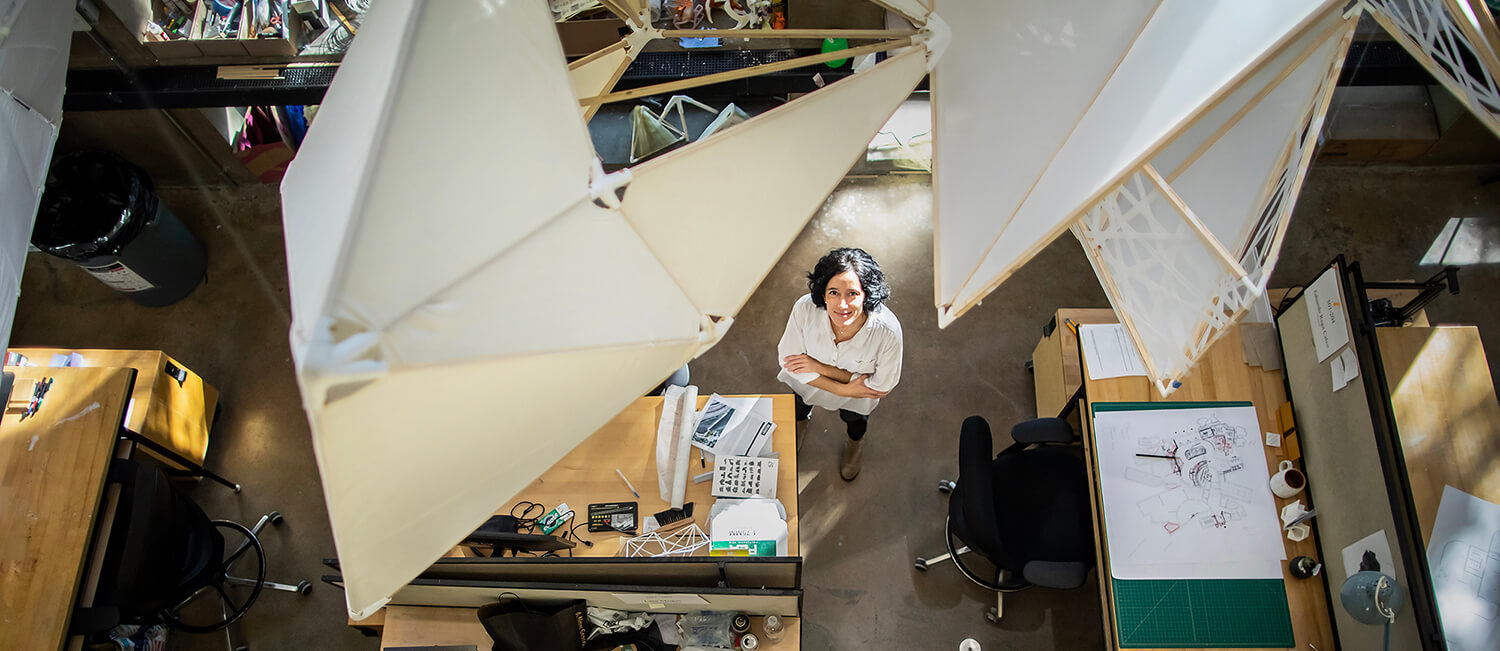 Laia Mogas-Soldevila in Meyerson Hall’s studio space looks up through “performative beacons,” student projects using lightweight natural materials.
Laia Mogas-Soldevila in Meyerson Hall’s studio space looks up through “performative beacons,” student projects using lightweight natural materials.
Laia Mogas-Soldevila is surrounded by possibilities—leather made from plants, ribbons of lattice that can filter air, sand structures that could replace concrete and rebar. She and the research team at DumoLab are experimenting with architecture using biomaterials that are healthy for humans and sustainable for the planet. Mogas-Soldevila is one of four researchers who share their science and their spaces in the fourth installment of People and Places at Penn.
From robotics on the Schuylkill River to chronic wasting disease in Pennsylvania woodlands to a basement grow chamber near the BioPond, these individuals are searching for new ways to understand wildlife ecology, environmental engineering, sustainable architecture, and plant biology.
Laia Mogas-Soldevila, DumoLab
Laia Mogas-Soldevila’s office is a modern-day curiosity cabinet. Seed pods, feathers, cocoons, and barnacles coexist alongside science fiction offerings: a translucent, shell-like substance that curls up and stretches out again without cracking, a pink-and-orange, hexagonal-patterned fabric that feels like high-sheen leather, and a perforated, plastic-looking material with a snakeskin motif. But of course, nothing here is plastic or leather. It’s all biomaterials, reverse-engineered to make everyday objects that will biodegrade after they’ve fulfilled their purpose.
Mogas-Soldevila is assistant professor of graduate architecture at the Weitzman School of Design and her work explores material design. Using nature as inspiration, Mogas-Soldevila repurposes biomaterials to form everyday objects out of silk, cellulose, sand, and shrimp skins—everything is fair game, as long as it’s biodegradable.
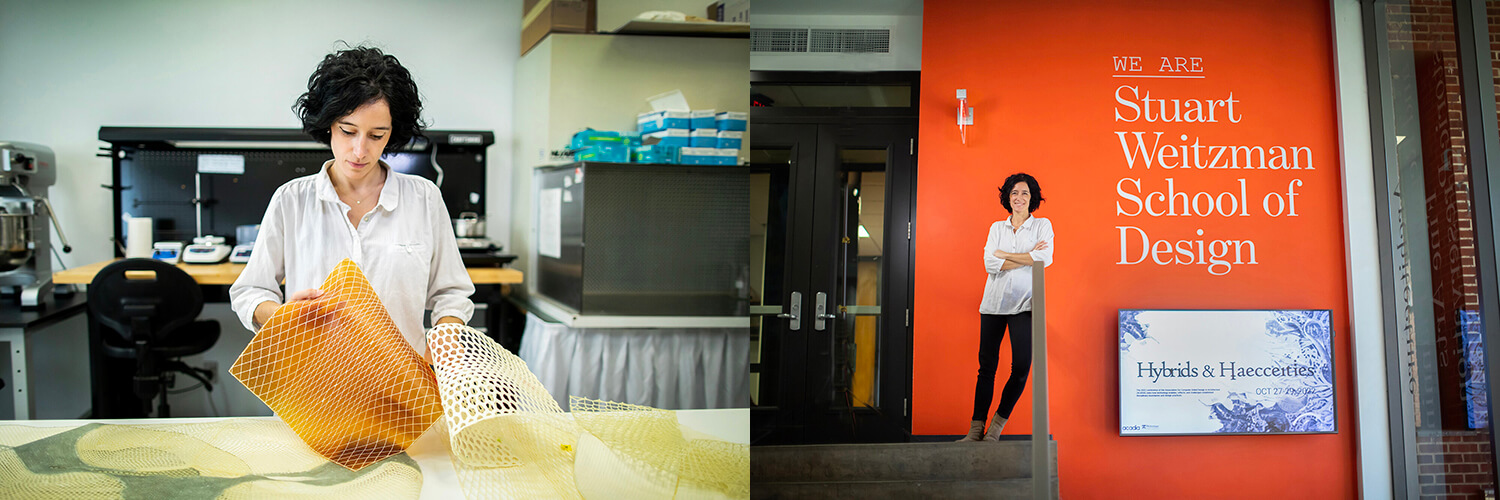 Mogas-Soldevila, a newly appointed professor at the Weitzman School of Design, creates biomaterials for architectural use, merging design with science. “If it was not beautiful, we would not do it,” she says.
Mogas-Soldevila, a newly appointed professor at the Weitzman School of Design, creates biomaterials for architectural use, merging design with science. “If it was not beautiful, we would not do it,” she says.
“Everything that we do is water-based,” Mogas-Soldevila says. “You, any human, is assembled in a water-based environment, in our mother’s womb. All this water-based fabrication already happens in nature, all the time.”
Her lab has created a water-based gel that feels like plastic when it dries, but will degrade when it gets wet again. The hope is that this material could replace petroleum-based products, Mogas-Soldevila says. “It’s the plastic bag that you can use a couple of days and then the third day, it’s almost cracked.”
Originally from Spain, Mogas-Soldevila’s first advanced degree was in architecture. But she graduated during a construction crisis, she says. “I had to change gears. What else was out there?”
Mogas-Soldevila earned an interdisciplinary Ph.D. working within a biomedical engineering lab, integrating biology and design at Tufts University, and two Master of Science degrees in design computation and digital fabrication from Massachusetts Institute of Technology.
Now at Penn, “my intent is to bring it all back to architecture,” Mogas-Soldevila says. She wants to scale up, making these materials affordable, durable, and accessible. Her DumoLab Research group, housed in Charles Addams Fine Arts Hall, is a room with 3-D printers and Hobart mixers that looks like a mix of an industrial bakery, an art studio, and a technology lab.
Everything DumoLab makes has to have aesthetic value. “If it was not beautiful, we would not do it,” Mogas-Soldevila says. She’s exploring materials that could replace leather, both in upholstery and in clothing, and alternatives for construction material, like concrete.
Together with a team of Penn undergraduates, Mogas-Soldevila will spend her summer building a dome structure from their new “concrete,” which has the color and texture of earth, a substance made not only of sand, but also biopolymers from shrimp shells, algae, calcium, and corn, along with natural fibers like flax, bamboo, and burlap. It looks like caramelized sugar and weighs like lead.
And, like everything else, the concrete substitute is water soluble. “If it comes in, it must go back to Earth without toxicity. And that’s a challenge,” Mogas-Soldevila says. A “decade, multi-decade challenge. That’s why it’s difficult. But it’s going to be very rewarding if we get there.”
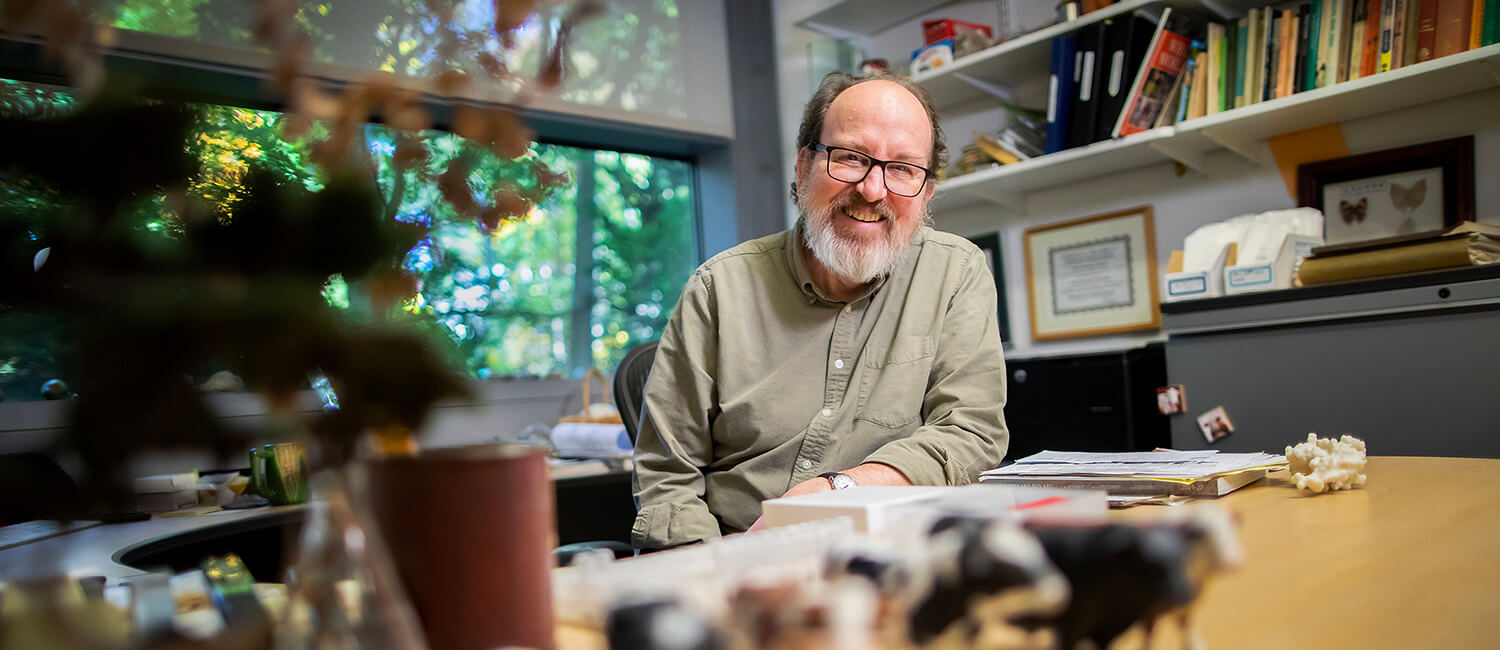 Scott Poethig in his office overlooking the BioPond.
Scott Poethig in his office overlooking the BioPond.
Scott Poethig, Poethig Lab
Born on the windy shores of Lake Erie in Buffalo, New York, Scott Poethig was quickly whisked away to tropical Manila by his parents, both Presbyterian missionaries. They wanted to immerse their son in Filipino culture and society, enrolling him in a local school. “In our biology class, when we had to dissect a frog, we had to bring the frog,” Poethig says.
For the last 40 years, Poethig has found a home at Penn as the John H. and Margaret B. Fassitt Professor of plant biology in the School of Arts & Sciences. He studies the transition between juvenile and adult development—everything from birth to puberty.
“Almost every aspect of the plant changes during the juvenile-to-adult transition,” Poethig says. “But, for many years, the vast majority of plant biologists didn’t know that [this transition] exists and certainly didn’t believe it was important.”
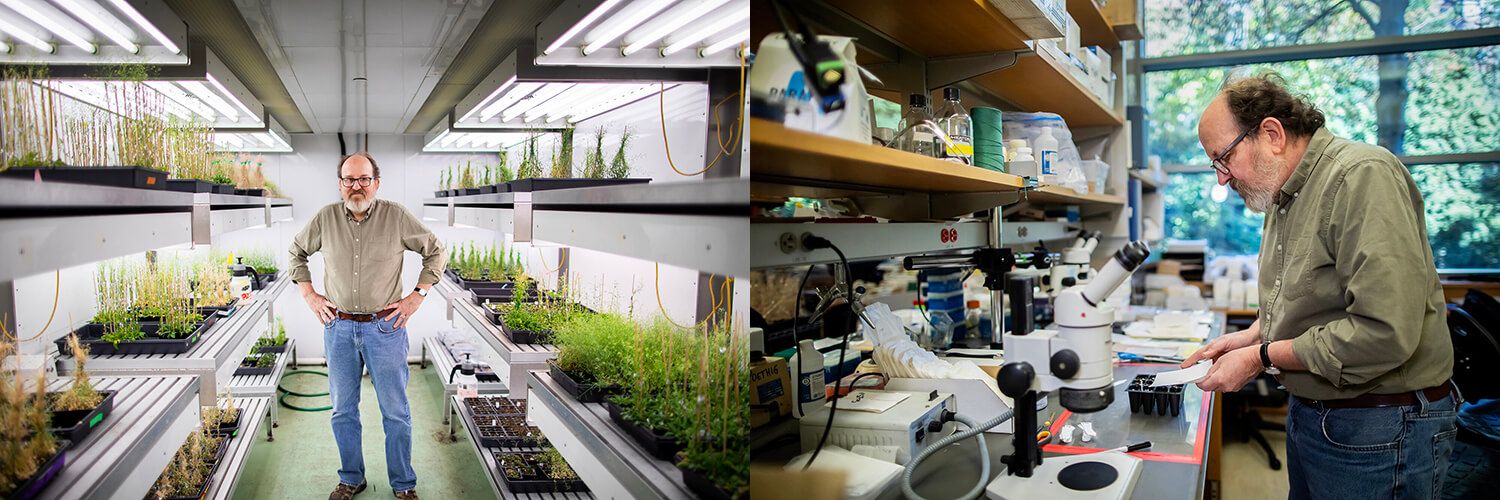 Poethig in one grow chamber filled with Arabidopsis thaliana (left) and in his laboratory (right).
Poethig in one grow chamber filled with Arabidopsis thaliana (left) and in his laboratory (right).
As it turns out, this transition controls many other processes, Poethig says. Photosynthetic efficiency differs, disease resistance varies, and almost every aspect of the shape of a plant—from its branching pattern to leaf shape—is differentially expressed in a juvenile plant, compared to its mature state.
Poethig discovered which gene controls maturation—a piece of small RNA called miR156. A large presence of miR156 suppresses the adult genes during the juvenile phase. When miR156 decreases, plants transition to the adult stage. Environmental impacts affect this as well, he says. Shade, for instance, delays the process.
Since 2006, Poethig has conducted his research at the Carolyn Lynch Laboratory, where ceiling-height glass windows look out onto Kaskey Park and the BioPond, framing a panoply of native species and their horticultural guests. In the fall, asters and toad lilies bloom in the understory. Tulip popular leaves yellow and fall, wafting down to rest on the understory.
Here, Poethig, three post-doctoral students, and one undergraduate conduct experiments on Arabidopsis thaliana, an inconspicuous, weedy-looking plant that, upon maturation, shoots up a flowering, foot-long stalk from a cluster of serrated leaves—and promptly dies.
With A. thaliana, the team is currently studying what Poethig calls “the master regulator of the final switch—reproduction.”
Every organism, both plants and animals, go through two major changes: somatic, or body change, and reproductive maturation, he says. “One of the big questions is, what is the relationship between vegetative phase change—the type of leaves the plant makes—and reproductive competence?”
People assume that physical maturation and reproductive competence are part of the same process, Poethig says, meaning that a plant will flower when it looks like an adult. “That’s what’s been assumed in plants for over 100 years,” he says. At Lynch Laboratory, results from the A. thaliana experiments show that these two processes are independently regulated. While miR156 controls many aspects of plant development, it does not inhibit reproduction.
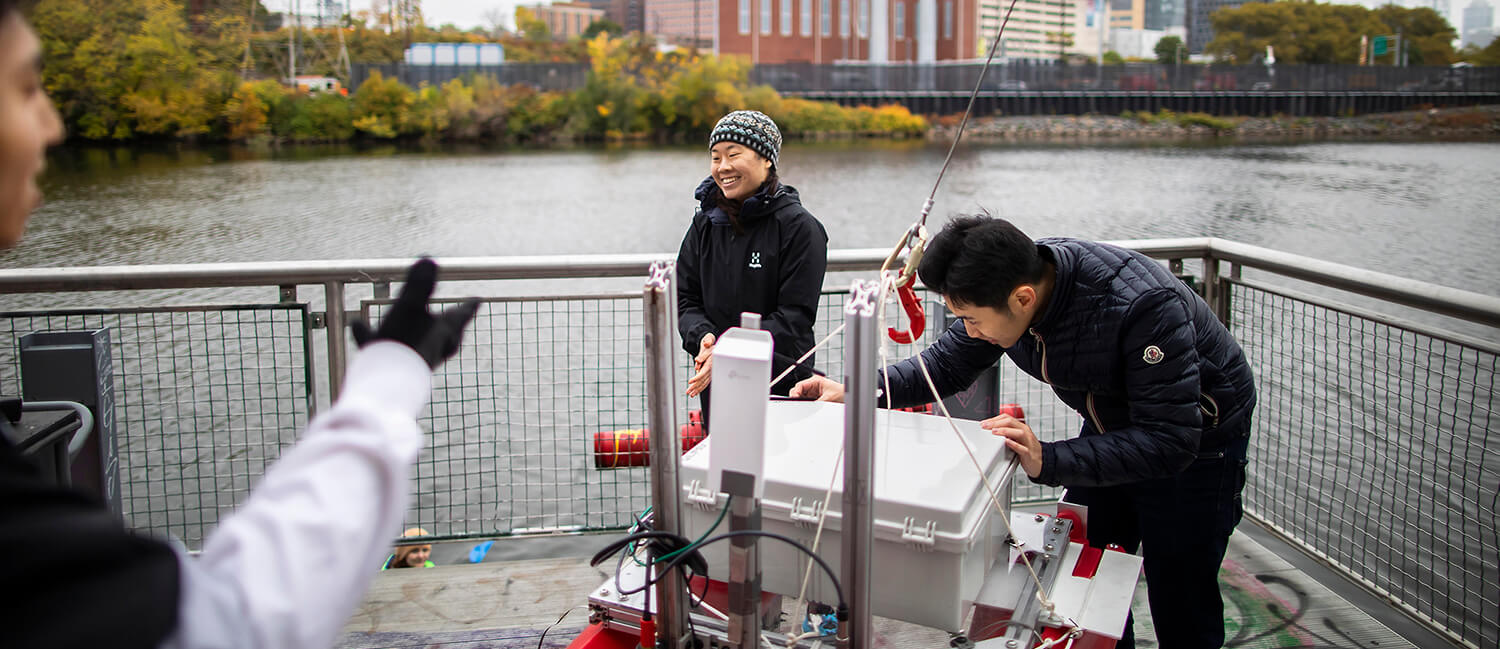 Alice Kate Li (center) and her six member team work on deploying the autonomous surface vehicle (ASV) with an on-board sensor suite, designed and tested with Yue Mao, Sixuan Liu, Sandeep Manjanna, Jasleen Dhanoa, Bharg Mehta, and Torrie Edwards, using a pulley system.
Alice Kate Li (center) and her six member team work on deploying the autonomous surface vehicle (ASV) with an on-board sensor suite, designed and tested with Yue Mao, Sixuan Liu, Sandeep Manjanna, Jasleen Dhanoa, Bharg Mehta, and Torrie Edwards, using a pulley system.
Alice Kate Li, Underwater Weather
On an early morning in late October, Alice Kate Li and five teammates bundle up in hats and coats and head down to the river to deploy a 45-pound robot. The project, called Underwater Weather, uses an autonomous surface vehicle kitted out with flame-red kayak pontoons to collect data on river sediment and flow dynamics, along with riverbed structure, tidal cycles, and storm flooding.
While it may look static, the Schuylkill River is tidally influenced, with about a five-foot difference between high-tide and low-tide, says Li, a Ph.D. candidate in the School of Engineering and Applied Sciences who works on Underwater Weather. The project is part of the ScalAR Lab at the General Robotics, Automation, Sensing & Perception (GRASP) Lab, housed in the Pennovation Center.
Information the Underwater Weather team gathers could allow them to predict the impact of floods on urban infrastructure (like bridges and piers), the river ecosystem, and drinking water quality. “With all this data that we’re collecting, we should be able to model the dynamics—but also then extrapolate to make predictions on environmental changes, while climate change causes more frequent tornadoes and hurricanes, and therefore floods,” Li says.
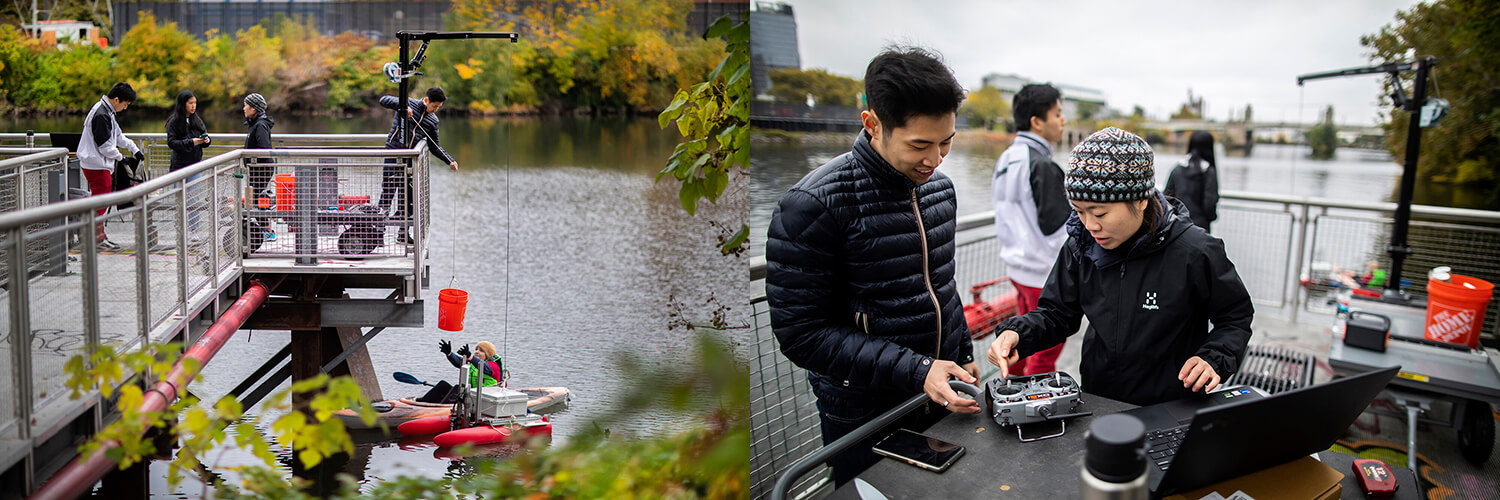 (Left) Ph.D. candidate Victoria Edwards in a kayak, who follows the ASV during deployments, receives tools from Jeremy Wang, a design and mechatronics engineer for the GRASP Lab. (Right) Li sets up the monitoring system.
(Left) Ph.D. candidate Victoria Edwards in a kayak, who follows the ASV during deployments, receives tools from Jeremy Wang, a design and mechatronics engineer for the GRASP Lab. (Right) Li sets up the monitoring system.
True to the GRASP Lab’s collaborative nature, the Underwater Weather team is working with Douglas Jerolmack and Hugo Ulloa in the Department of Earth and Environmental Science, who will use the amalgamated data to better understand river dynamics. “I really want my work to be impactful,” Li says. “I would love to take this data and, in the future, find out it is valuable for understanding the potential impacts of climate change.”
Originally from the south of England, Li spent her high school years in Hong Kong before moving to California for college. She spent two years at a community college before heading to the University of California, Irvine to study mechanical engineering. Now in her third year of the electrical and systems engineering doctoral program at Penn, Li is working on active sensing—creating robots that can make autonomous decisions in real time while they’re out in the field.
The GRASP Lab is a great place to do this work, she says. “I think a lot of it is the people, the environment as well—it’s highly collaborative and welcoming.”
The Lab’s large open space facilitates conversation, Li says. Everyone is “happy to discuss ideas that probably have nothing to do with their research,” she says, which makes students feel connected to others and their work.
Doctoral work can be lonely, Li says. “You can feel like, ‘Oh, what did I get myself into?’ But this kind of environment allows for people to stay sane, to stay motivated and inspired.”
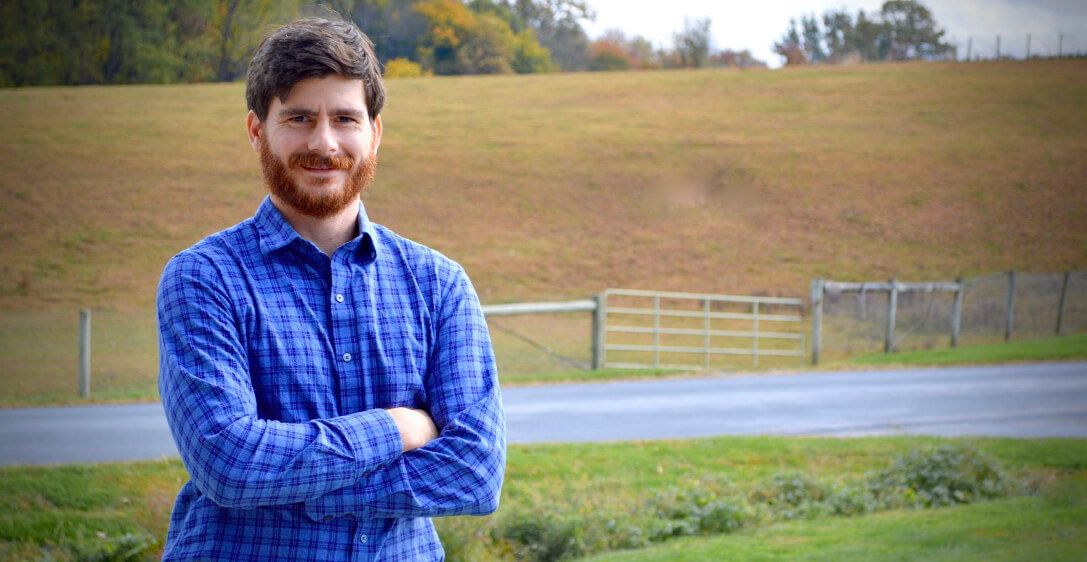 Roderick “Erick” B. Gagne on the New Bolton Center campus in Kennett Square, Pennsylvania.
Roderick “Erick” B. Gagne on the New Bolton Center campus in Kennett Square, Pennsylvania.
Roderick B. Gagne, Wildlife Futures Program
It’s autumn at the School of Veterinary Medicine’s New Bolton Center in Kennett Square and the rolling hills of Chester County, Pennsylvania transmuted into a tapestry of green and gold, if only for a few weeks. Placid cows dot the hills, hemmed in by white fences. A murmuration of starlings undulates in the sky.
Tucked off a gravel road on is the Wildlife Futures Program, which operates out of a stone farmhouse from 1792 and works in partnership with the Pennsylvania Game Commission on disease surveillance, management, and research in wildlife populations across the state.
The program works on a variety of diseases, including chronic wasting disease (CWD), a fatal neurological illness that affects a variety of members of the deer family and is transmitted by animal-to-animal contact, including through saliva, feces, and carcasses. The illness is caused by misfolded proteins, called prions. There is currently no vaccine, no treatment, and no cure. Once CWD is established, it can spread within area herds.
The Wildlife Futures team uses the enzyme-linked immunosorbent assay (ELISA) to detect protease-resistant proteins—a trait characteristic of prions—in CWD, says Roderick “Erick” B. Gagne, assistant professor of wildlife disease ecology. If positive, they administer an immunohistochemistry (IHC) screening, where a pathologist looks at a trimmed and stained piece of tissue under a microscope to look for look for evidence of binding with a prion-specific antibody. “That’s the gold standard,” Gagne says.
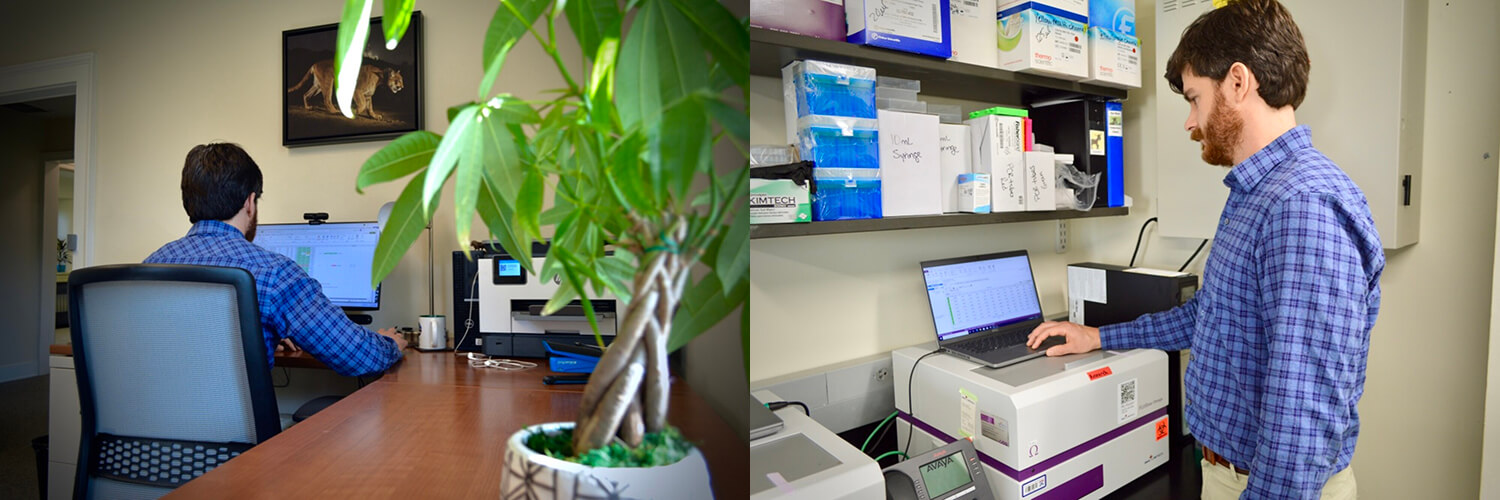 Gagne works at his desk (left) and monitors test results (right).
Gagne works at his desk (left) and monitors test results (right).
The team is also experimenting with the real-time quaking-induced conversion (RT-Quic) test, which is more sensitive than ELISA, Gagne says—similar to a real-time COVID PCR test.
“The potential is for early detection of CWD,” he says. “We’re looking at where the prion is in animals in the wild, and then trying to address, or start to think about, how it’s getting there.”
Pennsylvania’s deer hunting season is their busiest time of year. The 27-member team spends months gearing up, hiring additional staff and buying lab equipment and supplies. By the first Saturday after Thanksgiving, it’s all hands on deck, says Gagne. The program processes thousands of samples per week, he says, each from separately tagged white-tailed deer.
To do so, the Wildlife Futures Program works collaboratively with management agencies, developing research questions together and applying novel approaches to find solutions. “Disease is becoming increasingly recognized as something that wildlife management agencies need to deal with,” Gagne says. “I envision this academic and state agency partnership only increasing. It’s a really good roadmap to actively solve urgent and immediate issues.”
Gagne is a new hire, not quite two years into his position, which he accepted just before the birth of his first child. With a full beard and a quiet demeanor, Gagne is here to put down roots, to help mold the program’s future. It has “a real, tangible feeling—like your work is making a difference,” he says. “It’s kind of exciting to see just how quickly it can take shape. And then having that happening at a university like Penn just really leverages the potential of what we can do.”